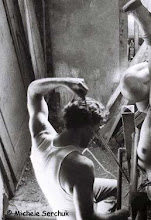The eastern tradition, being steeped in its own myth systems and of a more contemplative orientation generally (as opposed to idealized (in the Platonic sense) or rule-driven, like in the west of at least the last several millennia), does not deviate, I think, from the general outline I’ve given thus far. In the east submission is essentially a feminine, Dionysian narrative, but the tradition in bondage in the east proceeds less from an intuition of sex as a biological imperative and more as a means of transcendence. We may look to the Kama Sutra for a conspectus of the eastern belief in the mystical virtue of the erotic, but erotic bondage gives us a unique kind of on-demand system for inducing transcendent states. The Japanese in particular have developed an architectonic for bondage that is observant of several eastern modes of mystical attainment - notably yoga, the hatha variation of which imparts several asanas to the standard kinbaku kamae. I won’t go so far as to insist that Japanese bondage is single-mindedly about seeking communion with the godhead, but I do believe that impulse to be one of the foundational stimuli for its emergence from the contemplatively derived martial disciplines preceding it, and one of its principle distinctions from western bondage.
One observes in stock kinbaku imagery a manner of submission, a going into the experience, as it were, that is far less characteristic of the western idiom, which itself traditionally emphasizes the resistance of the person being tied. The western “damsel’s” situation is being imposed from without; the agency of her helplessness is external and she usually goes along only reluctantly. She is, in a broader narrative sense, not responsible for her tribulations - she is a victim. One need not go far into either ancient or modern myth systems in the west to see the subjugation of the mortal individual to willful cosmic forces, often personified, which act pointedly on mortal posterity. The problem of predestination versus free will comes up so reliably in the west because we insist upon thinking of our existence as individuated selves, free agents in other words. There is very little impetus to endorse willing submission in western thought systems; it defies a long and acculturated tradition of separation - from God and from each other. Submission in the west is, I would suggest, a radical and even subversive act. If you’re going to give in, best not to be too obvious about it.
The idea of the monad, or the unbroken continuity between apparently individuated phenomena is axiomatic to Buddhist thought since at least the time of Bodhidharma (about 500AD), and well developed in other eastern traditions. Consider the Hindu idea of the veil of Maya, before which we labor with the problem of duality. Behind the veil, there is no separation and duality is revealed to be an illusion. Whereas the separation from ultimate principles (the “fall from grace”) is believed to be a fact in western ontologies, eastern disciplines stress only the illusion of separation overlaying the fact of unity. To the eastern mind, the same energy flows through all apparently individuated things, as, for example, revealed in the meridian systems of oriental medicine. Open, boxy, and irregular kinbaku architecture intentionally plays with these meridians, with the crossing and rearrangement of energies and the possibility thereby of a look into ultimate principles. That it becomes in the making highly erotic only compounds its force and potentials. The classic M-jo in the Japanese tradition thus goes quite willingly into her restraint and, while not necessarily embracing her suffering, accepts it as consistent with the pain of illusion such as we know on this side of the veil. Although the Shinto tradition wedded to Zen does not say much about the antecedent Hindu concept of Maya, it does predicate satori as the endpoint of suffering wherein the truth of unity is made manifest to the spirit.
Of course, all of this is available to the western bondage practitioner too, and it could easily be said that the rope top is performing a kind of priestly function in any case. The overwhelming emphasis on resistance to being restrained in the popular conception of bondage in the west, as opposed to ready yielding characterizing the eastern conception, is, I think, consistent with much larger mytho-poetic, and hence social, constructs inhering in both. It may be difficult to describe what the salient differences are between eastern and western traditions in bondage (I mean, hands get tied behind the back in both cases), but it becomes easier when we couch our interest more broadly in the two world views.

19 July, 2009
Separated at Birth? (Pt. 3)
Labels:
aesthetics,
Apollo,
art,
BDSM history,
bondage,
Dionysus,
fine art,
gagging,
John Willie,
nature,
photography,
porn,
shibari,
women
Subscribe to:
Post Comments (Atom)



















2 comments:
Brilliant, Mac. Love it. Hopefully time to discuss this wk.
D
Lovely post Mac Sir. Hope we can chat again soon!
(lost kitten)
Post a Comment